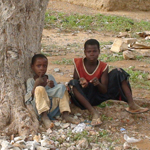Social and Economic Resilience
- U.N. Economic and Social Council, Commission on Population and Development. 2009. World Demographic Trends: Report of the Secretary-General. 1-22. New York: United Nations E/CN.9/2009/6.
- Human Security Centre. 2005. Part 1 The changing face of global violence. In Human Security Report 2005: War and Peace in the 21st Century, 13-60. New York: Oxford University Press.
- Webb, Patrick. 2010. Medium-to long-run implications of high food prices for global nutrition. Journal of Nutrition 140 (1): 143S-147S.
- United Nations Development Programme. 2004. Chapter 1 Development at risk. In Reducing Disaster Risk: A Challenge for Development, 9-28. New York: UNDP.
- Dasgupta, Partha (Lead Author); S. Niggol Seo (Topic Editor). 2008. Natural capital and economic growth. In Encyclopedia of Earth, ed. Cutler J. Cleveland. Washington, D.C.: Environmental Information Coalition, and National Council for Science and the Environment.
- Munasinghe, Mohan. 2010. Section 1.4 Millennium development prospects and worldwide status. In Making Development More Sustainable (2nd Edition), 26-31. Colombo, Sri Lanka: Munasinghe Institute for Development.
- Matson, Pamela, Amy Luers, Karen Seto, Rosamond Naylor, and Ivan Ortiz-Monasterio. 2005. People, land use and environment in the Yaqui Valley, Sonora, Mexico. In Population, Land Use, and Environment, eds. B. Entwisle and P. Stern, 238-264. Washington, D.C.: National Research Council.
- Holling, C. S. 2001. Understanding the complexity of economic, ecological, and social systems. Ecosystems 4 (5): 390-405.
- Turner II, Billie L., Roger E. Kasperson, Pamela A. Matson, James J. McCarthy, Robert W. Corell, Lindsey Christensen, Noelle Eckley, Jeanne X. Kasperson, Amy Luers, Marybeth L. Martello, Colin Polsky, Alexander Pulsipher, and Andrew Schiller. 2003. A framework for vulnerability analysis in sustainability science. Proceedings of the National Academy of Sciences 100 (14): 8074-8079.
- Jack, B. Kelsey, Carolyn Kousky, and Katharine R. E. Sims. 2008. Designing payments for ecosystem services: Lessons from previous experience with incentive-based mechanisms. Proceedings of the National Academy of Sciences 105 (28): 9465-9470.
- Lebel, Louis, Antonio Contreras, Suparb Pasong, and Po Garden. 2004. Nobody knows best: Alternative perspectives on forest management and governance in Southeast Asia. International Environmental Agreements: Politics, Law and Economics 4 (2): 111-127.
- York, Richard, Eugene A. Rosa, and Thomas Dietz. 2003. STIRPAT, IPAT and ImPACT: Analytic tools for unpacking the driving forces of environmental impact. Ecological Economics 46: 351-365.
- National Research Council, Committee on Risk Characterization. 1996. Summary. In Understanding Risk: Informing Decisions in a Democratic Society, eds. Paul C. Stern and Harvey V. Fineberg, 1-10. Washington, D.C.: National Academies Press.
- Levin, Simon. 2010. Complex adaptive systems and the challenge of sustainability. In Toward a Science of Sustainability, eds. Levin, S. A. and William C. Clark. Report from Toward a Science of Sustainability Conference, Airlie Center, Warrenton, Virginia, November 29, 2009 – December 2, 2009, 83-86. Princeton, NJ: Center for Biocomplexity, Environmental Institute, Princeton University and Cambridge, MA: Sustainability Science Program, Center for International Development, Harvard University.
- Janssen, Marco A., and Elinor Ostrom. 2006. Empirically based, agent-based models. Ecology and Society 11 (2): 37.
- Bongaarts, John. 1994. Population-policy options in the developing world. Science 263 (5148): 771-776.
- Kates, Robert W. 2000. Population and consumption: What we know, what we need to know. Environment 42 (3): 10-19.
- Colten, Craig E., Robert W. Kates, and Shirley B. Laska. 2008. Three years after Katrina: Lessons for community resilience. Environment: Science and Policy for Sustainable Development 50 (5): 36-47.
- Collier, Paul. 2007. Poverty reduction in Africa. Proceedings of the National Academy of Sciences 104 (43): 16763-16768.
- Mabogunje, Akin. 2007. Tackling the African poverty trap: The Ijebu-Ode experiment. Proceedings of the National Academy of Sciences 104 (43): 16781-16786.
- Aspinall, Edward. 2005. Aceh/Indonesia: Conflict analysis and options for systemic conflict
transformation. Prepared for the Berghof Foundation for Peace Support. Berlin: BFPS.
Some references cited from: Kates, Robert W., ed. 2010. Readings in Sustainability Science and
Technology. CID Working Paper No. 213. Center for International Development, Harvard
University. Cambridge, MA: Harvard University, December 2010.


